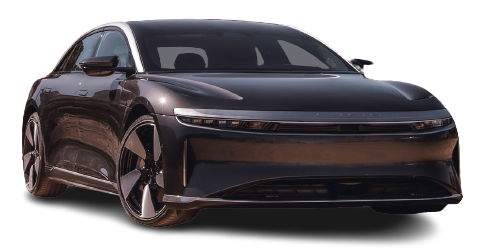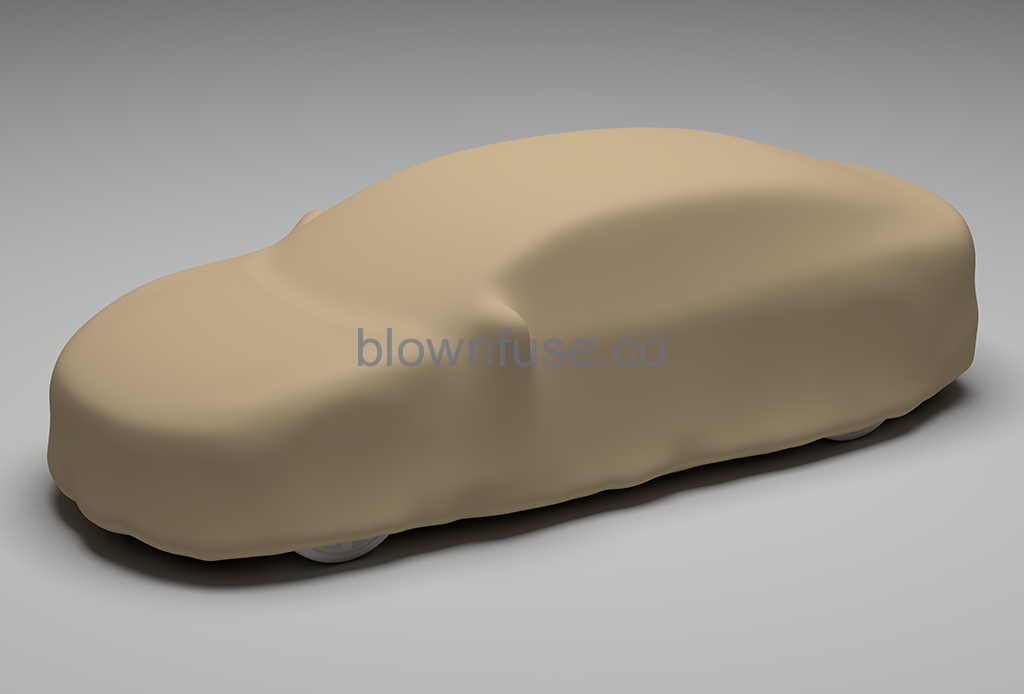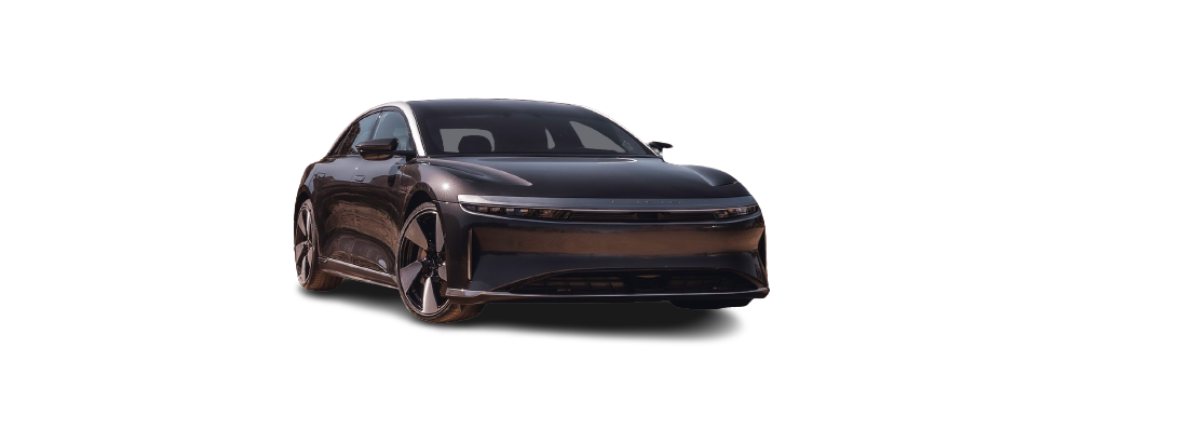2022 Lucid Air Vehicle Care

Cleaning the Exterior
WARNING: Never charge your vehicle while washing it. Unplug the charging cable and close the charge port cover. Liquids entering the charge port while the cable is plugged in could result in serious personal injury, as well as damage to the vehicle, charging equipment, or property.
WARNING: After washing the vehicle, wet brakes can result in longer stopping distances. To dry the brakes, drive the vehicle slowly while gently pressing the brake pedala few times to warm up the brakes.
Your vehicle should be washed regularly to preserve the finish and maintain its overal appearance.
To protect the paint surfaces, wash your vehicle as soon as possible:
- When mud, dust, soot, or dirt builds up on the surface
- After driving on coastal roads or winter roads treated with salt
- When corrosive contaminants such as tree sap, bird droppings, or bugs collect on the surface
- After a rainfall to prevent possible damage from acid rain
ENVIRONMENTAL: It is illegal to pollute drains, rivers, and waterways. Some cleaning products
contain chemicals that are hazardous to the environment. Used toxic chemicals must be
disposed of at authorized waste disposal sites only. Always take precautions to prevent fluids
from spilling.
Hand washing
CAUTION: Avoid using rough or tightly-napped cloths (such as washing mitts) on the vehicle, as these can be abrasive enough to damage the finish.
CAUTION: Avoid washing your vehicle in direct sunlight. Water and cleansers dry faster on a hot surface and can leave water spots or stains.
When washing your vehicle by hand, follow these steps:
- Rinse the entire vehicle first to remove as much excess dirt and dust as possible and reduce the risk of scratches from washing.
- Wash using a clean, soft cloth or sponge and cold or lukewarm water mixed with a mild car soap.
- Rinse your cleaning tools often to avoid rubbing debris into the finish, especially if your vehicle is exceptionally dirty.
- Do not aim water hoses directly at window, door, or hood seals, or through wheel apertures onto brake components.
- After washing, rinse the vehicle thoroughly with clean, cool water until all the soap has been removed.
- To avoid leaving water spots on the finish, dry the vehicle thoroughly with a chamois or cotton cloth.
Removing tar spots
CAUTION: Do not use acidic, abrasive, or petroleum-based cleansers, as these can damage the vehicle’s paint and the plastic or metal parts.
You can use denatured alcohol to remove tar spots and stubborn grease stains from paint.
After cleaning, immediately wash the area with soapy water to remove the alcohol.
Automatic car washes
CAUTION: Do not use a car wash that applies cleansers containing acid. Acid can react with the plastic in some vehicle components and damage them. Always check with your car wash to confirm that acid is not used.
CAUTION: Leave the windshield wipers in the off position while in a car wash to avoid damaging them.
Lucid recommends using only touch-free automated car washes that do not bring brushes or other cleaning tools in direct contact with the vehicle body.
NOTE: Vehicle or paint damage caused by using an automatic car wash will not be covered under the vehicle warranty.
Pressure washers
CAUTION: Do not use a pressure washer with a circular jet or bristle attachment, as it could damage the surface finish of components.
CAUTION: Pressure washers that have a pressure exceeding 1,200 PSI (82 bar) can damage or even remove vehicle paint if used improperly.
CAUTION: Do not use a hot or steam pressure washer with a temperature exceeding 120°F 48°C), as this could remove paint and surface protection from exterior parts.
Keep the nozzle at least 12 inches (30 cm) from the surface of the vehicle. Always keep the nozzle moving and do not concentrate the spray on a single area.
Do not aim the pressure washer at any of the following:
- Door and window seals
- Roof seals
- Ventilation intakes
- Plastic trim components
- Electrical components
- Exterior cameras or sensors (see ADAS Component Locations)
- Tires and brake system components
NOTE: Vehicle or paint damage caused by usinga pressure washer will not be covered under the
vehicle warranty.
Underbody maintenance
If salt has been used on the roadways (such as during winter months), thoroughly remove all traces of road salt. Use a hose to rinse salt from the underside of the vehicle.
Flush away accumulations of mud in areas where debris easily collects (such as wheel arches and panel seams).
Wheels
CAUTION: Do not use chemical-based wheel cleaners, as these can damage the finish of the wheel.
Wash the wheels with warm, fresh water containing a good quality wash and wax shampoo. Thoroughly rinse the wheels to remove any soap residue.
Windshield, windows, and mirrors
CAUTION: Mirror glass is particularly susceptible to damage. Do not use abrasive cleaning compounds. You should regularly clean all windows inside and out using a window cleaning solution. An automotive glass cleaner is recommended.
After washing your vehicle with washing or waxing products, clean the outside of the windshield with glass cleaner.
Wiper blades
You should clean wiper blades using isopropyl (rubbing) alcohol or windshield washer fluid. Do not use petroleum-based cleaners.
Polishing. Paint, and Body Repairs
- CAUTION: Always wash your vehicle before waxing or polishing.
- CAUTION: Do not polish or wax your vehicle in direct sunlight.
- CAUTION: Do not use wax or polish containing any harsh abrasives, cutting compounds, or cleansers that may damage the vehicle finish. If in doubt when choosing a product, please contact Lucid for recommendations.
- CAUTION: Carefully read and follow all of the instructions provided by the manufacturer of the wax or polish product.
Regular waxing helps to protect the paint surfaces from harsh elements and maintain their appearance. After the first year, Lucid recommends polishing your vehicle before reapplying wax. Polishing removes built-up residue and keeps the surface of the finish even.
The exterior paint should be regularly checked for damage. Any minor scratches or chips should be repaired as soon as possible using touch-up paint (contact Lucid for recommendations).
Body repairs should only be performed by a body shop approved by Lucid. Contact a Lucid Service Center for assistance in locating an approved body shop near you.
Using a Car Cover
CAUTION: Never use a car cover when the vehicle is plugged in, as this can prevent the battery from being adequately cooled during charging.
To preserve the cosmetic appearance of the body when the vehicle is not being used, you may wish to use a car cover.
Cleaning the Interior
General cleaning
- WARNING: Exposure to chemicals in some cleaners can be hazardous and can irritate eyes and skin. Always read and follow the manufacturer’s instructions when using cleaning products.
- WARNING: Do not splash or spill liquids in the vehicle, as this could cause an electrical component to malfunction or catch fire. Any spills should be immediately wiped up using a clean, dry cloth.
- CAUTION: Do not apply cleaning products directly to the surface being cleaned. Instead, apply non-solvent-based cleaning products to a soft cloth and then apply to the surface being cleaned. Cleaning products entering into components may cause damage or impair their function.
- CAUTION: Avoid using solvents (including alcohol), bleach, citrus, naphtha, or silicone-based products or additives on interior components, as these can damage the appearance of the material.
To maintain the look and appearance of the interior of your vehicle, you should inspect and clean the interior frequently.
For general cleaning, it is recommended that materials and surfaces should be cleaned using a non-solvent-based cleaning (wet) wipe, and dried with a microfiber cloth.
If possible, try to wipe up spillages and clean marks as soon as they happen. This will reduce the need for more extensive cleaning in the future.
NOTE: It is advisable that you test all cleaners on a concealed area before use.
Interior glass and mirrors
CAUTION: Do not scrape surfaces or use abrasive cleansers or cloths, as this could cause damage to some surfaces (such as the heating elements).
Use an alcohol-based commercial glass cleaner and a soft cloth (such as microfiber) to clean any glass or mirrored surfaces.
Displays
WARNING: Do not use polish or wax cleaners on the display screens. Polished surfaces are reflective and may interfere with the driver’s view, resulting in an accident.
CAUTION: Do not use statically-charged materials (such as a cloth that was recently machine washed and dried) on the displays.
CAUTION: Do not use cleansers (such as glass cleaner) to clean displays.
Display screens should only be cleaned using a soft, lint-free cloth designed for cleaning screens and monitors.
Before cleaning the display screens, use the Pilot Panel to enable screen cleaning mode to prevent accidental operation of vehicle controls. Select ![]() >
> ![]() Displays> Displays & Accessibility> SCREEN CLEANING MODE.
Displays> Displays & Accessibility> SCREEN CLEANING MODE.
Airbags
WARNING: Airbag covers should only be cleaned using a slightly dampened cloth or cleaning wipe. Water or any other liquid entering into an airbag or its associated electrical wiring may cause the airbags to deploy or not function properly in an accident.
WARNING: Any damage or cracks on an airbag cover should be referred to a Lucid Service Center for inspection.
Seats
WARNING: Never use steam or upholstery cleaners on the seats, or any cleaning method that would saturate the seat with liquid. This can damage the occupancy weight sensor in the seat, which in turn can affect the operation of the airbag system and result in serious injury or death.
For cloth seats:
- If necessary, gently vacuum the seats first to remove any loose dust, dirt, or debris.
- Use a soft, colorless cloth moistened with warm water and (if necessary) non-detergent soap. Wipe gently in a circular motion. Allow the seats to air dry after cleaning.
For leather and artificial leather seats:
- To clean, use a soft, colorless cloth moistened only with warm water. Do not use polishes, oils, cleaning fluids, solvents, or detergents.
- Avoid vacuuming. Instead, use your moistened cleaning cloth to gently remove any loose particles.
- Application of a leather conditioner is not necessary to maintain the original condition of the seats.
Seat belts
WARNING: Never allow any substance to enter a seat belt mechanism, as this can negatively affect its performance in an impact.
Extend the seat belt and clean using a cloth moistened only with water. Do not use any type of detergent or chemical cleaning agent. Allow the belts to air dry while extended, away from direct sunlight if possible. Chrome and metal surfaces
Do not use abrasive cleansers, rough cloths, or polish, as these materials can damage the finish of these surfaces.
Plastic materials
WARNING: Do not use polish or wax cleaner on the upper surfaces of the dashboard. Polished surfaces are reflective and may interfere with the driver’s view, resulting in an accident.
You should clean heavily-soiled plastic surfaces using warm water and a non-detergent soap, then wipe clean with a soft cloth.
Carpets and floor mats
Vacuum the carpets and mats thoroughly before cleaning to remove excess dirt and debris. Avoid over-wetting the carpets. A diluted upholstery cleaner can be used on heavily soiled areas.
Remove floor mats before cleaning to ensure that they dry properly afterwards. Clean using a microfiber cloth and water or a mild textile cleanser. Spot-test any cleansers first to ensure they will not leave stains. Drv the mat thoroughlv before reinstalling.
Floor Mats
- WARNING: Loose or improperly-fitted floor mats could interfere with the operation of the foot pedals, which could lead to loss of vehicle control and a collision.
- WARNING: Do not place additional floor mats over the existing ones.
- WARNING: Always install floor mats with the correct side facing up. Do not turn them over.
Using genuine Lucid floor mats can extend the life of your vehicle’s carpet and make it easier to clean. Mats should be maintained with regular cleaning and replaced if they become worn or damaged.
Floor mats should be inspected periodically to ensure they are properly installed. Lightly pull on the mat to check that it is securely fastened. Depress each foot pedal fully and reinstall the mats if any interference is felt.

